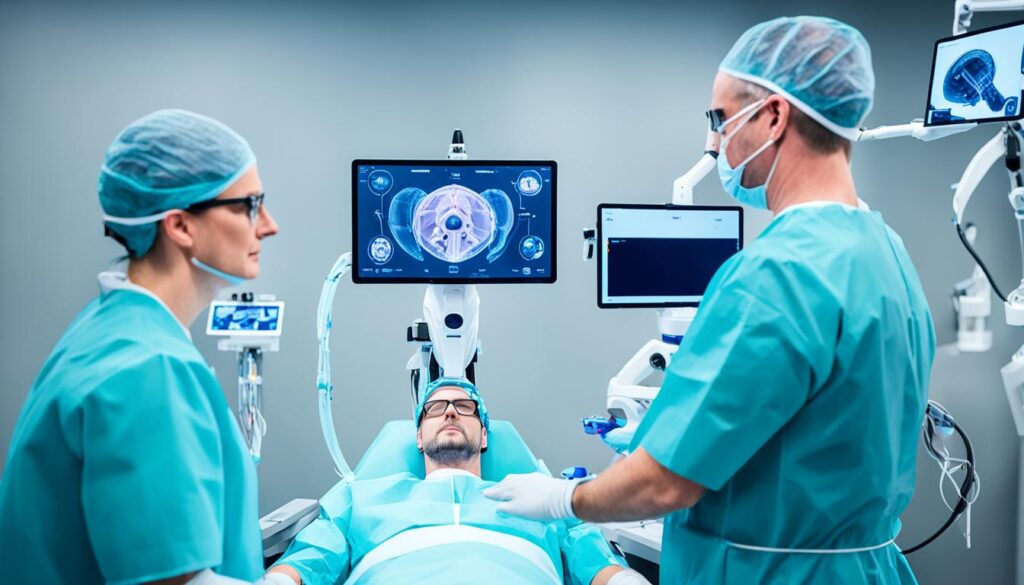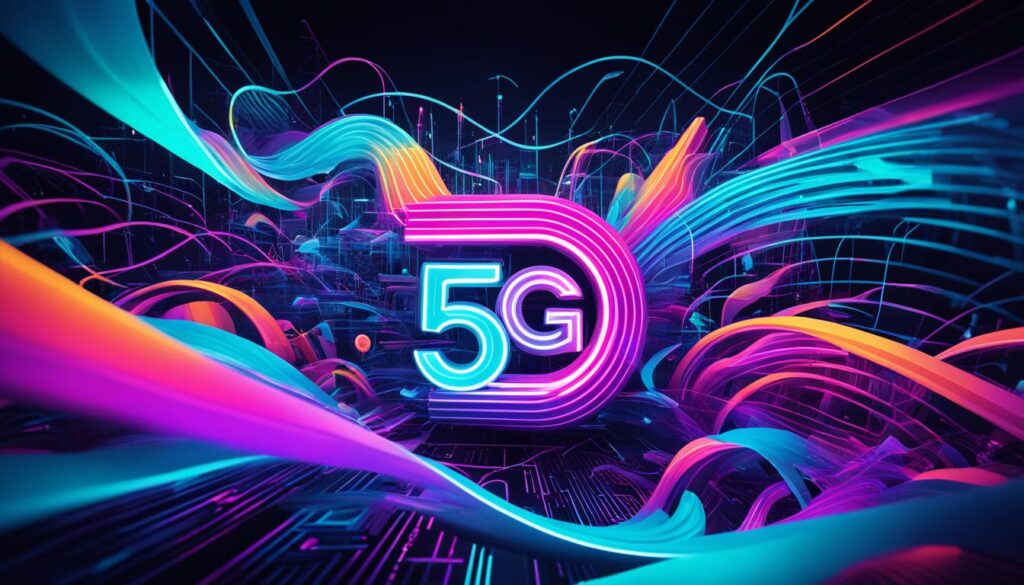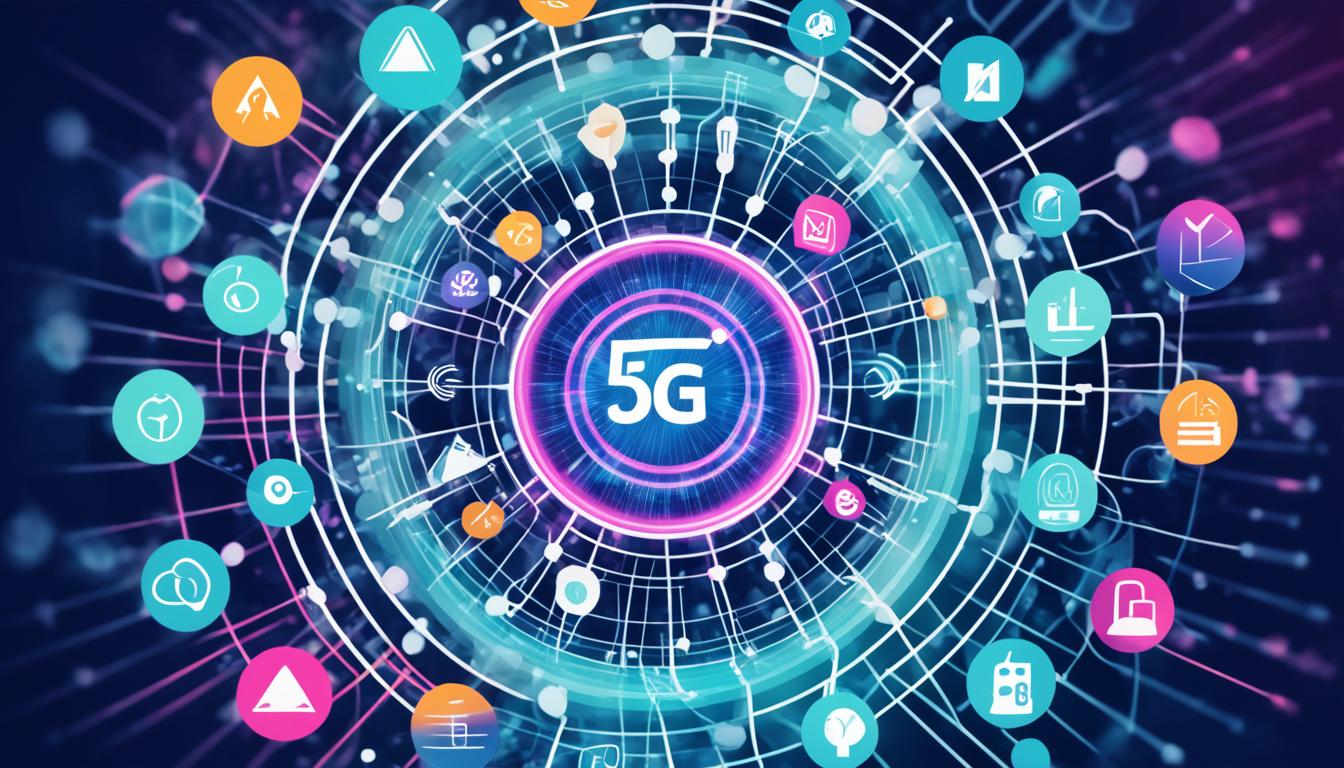The launch of 5th Generation (5G) mobile networks has sparked worries about health risks. 5G uses higher frequency bands than before, making people wonder about the safety of the increased radiofrequency (RF) exposure. This piece looks into the possible health effects of 5G, checking out the science, global guidelines, and ways to lower risks.
Key Takeaways
- False conspiracy theories linking 5G to COVID-19 have spread, but experts say these claims are not true.
- Research shows 5G’s radio frequency levels don’t significantly affect health, staying well under safety limits.
- RF radiation might possibly cause cancer, but 5G’s exposure levels are likely to be lower than earlier networks.
- Global rules and guidelines work to keep the public safe from 5G and other wireless tech risks.
- 5G brings many benefits, like better healthcare through telemedicine and remote checks, but it’s important to address public concerns.
What is 5G Technology?
5G, or fifth generation, is the newest wireless mobile phone technology. It started in 2019. It aims to offer better performance and new applications, like improving e-Health services.
5G Networks and Frequency Bands
5G will use higher frequencies, up to tens of GHz, which are new for mobile phones but common elsewhere. It will also use beam-forming antennas. These antennas send signals more directly to devices, unlike current antennas that spread signals widely.
- Low-band 5G operates at frequencies less than 1GHz and can span great distances.
- Mid-band 5G lies in the 1-10GHz range, covering most modern mobile and Wi-Fi frequencies.
- High-band 5G, known as millimeter-wave, functions in the 20-100GHz range for consumer applications.
Key Differences from Previous Generations
5G is much faster than older technologies, promising ten times the data speed. This speed boost will open up new services and change many areas of life.
“5G will extend into higher frequencies around 3.5 GHz and up to a few tens of GHz, which are new to mobile phone networks but commonly used in other applications.”
Potential Health Risks of 5G
The new 5G wireless technology has made people worry about its health effects. 5G uses higher frequencies, from 3.5 GHz to tens of GHz. But, the exposure from 5G is similar to what we get from current mobile phone towers. Many studies have looked into this and found no harm.
Radio waves from 5G mainly cause tissue heating, but this heating is very small. The higher frequencies in 5G might make energy absorption more intense near the body’s surface. This could affect the skin and eyes. With more base stations and devices, exposure levels can change a lot for people.
Studies suggest that certain frequencies might affect men’s fertility and could also impact women’s fertility. They might also harm the development of embryos, fetuses, and newborns. This shows we need more research on these higher frequencies.
Guidelines from groups like the ICNIRP and IEEE cover frequencies up to 300 GHz, including 5G. The WHO is also looking into the health effects of radiofrequencies, including 5G. They plan to share their findings by 2022.
| Key Findings | Details |
|---|---|
| Tissue Heating | Tissue heating is the main interaction mechanism between radiofrequency fields and the human body. Current exposure levels result in negligible temperature rise. |
| Exposure Levels | Exposure from 5G infrastructures at around 3.5 GHz is currently similar to that from existing mobile phone base stations. |
| Potential Effects | Research indicates potential effects on male and female fertility, as well as embryo, fetus, and newborn development at frequencies between 450 and 6,000 MHz. |
| Exposure Guidelines | International guidelines from ICNIRP and IEEE cover frequencies up to 300 GHz, including those used by 5G. |
| WHO Assessment | The WHO is conducting a health risk assessment on the effects of exposure to radiofrequencies, including 5G, to be published by 2022. |
5G Exposure Levels and Mechanisms
5G is the latest wireless technology, offering faster data and better communication. But, there are worries about its health effects. People are concerned about how 5G interacts with our bodies.
Radiofrequency Exposure Compared to 4G
5G doesn’t expose us to more radiation than 4G. But, its signals can vary based on where you are and how you use it. This means exposure can change a lot.
Absorption and Penetration at Higher Frequencies
Higher frequencies in 5G don’t go deep into our bodies. They mainly hit the skin and eyes. This makes our skin and eyes more at risk from 5G radiation.
Some studies suggest 5G might increase the risk of skin cancers. They also point out health problems from using 5G technology in real life. This shows there could be dangers.
“The role of oxidative stress in carcinogenesis was discussed in relation to the biological activity of low-intensity radiofrequency radiation associated with 5G technology.”
We need more research to understand 5G’s effects on health and the environment. It’s important to study how 5G’s higher frequencies interact with our bodies. This will help us know the long-term risks.
5G Health Risk: Scientific Evidence
Scientists are looking into how 5G technology might affect our health. They want to know about the risks from radiofrequency (RF) radiation. So far, no health problems have been linked to wireless tech. But, the new frequencies in 5G have made some people worried.
Studies on RF Radiation Exposure
Many studies are looking at the effects of 5G’s higher frequencies. The National Toxicology Program’s studies tested rats with a lot of radiation. They found no health issues in rats or mice, even with levels much higher than what people face.
The International Agency for Research on Cancer (IARC) says radio frequency fields might increase cancer risk (class 2B). But, brain cancer rates haven’t gone up since 2013, even with more people using phones. This suggests no direct link between phones and brain cancer.
A U.S. Department of Health study in 2018 found a link between high RF radiation and cancer in male rats. But, female rats and mice didn’t show the same results. These rats were exposed to radiation from phones for two years.
Even with some mixed results, research shows no health issues from mobile phone and wireless network radio waves. Scientists are still looking into the long-term effects of 5G. Studies comparing areas with and without 5G could help us understand its health effects better.
International Exposure Guidelines
The International Commission on Non-Ionizing Radiation Protection (ICNIRP) and the Institute of Electrical and Electronics Engineers (IEEE) have set guidelines for radiofrequency exposure. These include the frequencies used by 5G. Their goal is to keep people safe from harm caused by radiofrequency exposure, like tissue heating and nerve stimulation.
ICNIRP and IEEE Guidelines
The ICNIRP guidelines make sure that 5G technologies don’t cause health problems. They update these guidelines with new science on RF EMFs and health effects. This helps keep exposure rules up to date.
The IEEE guidelines also protect against health risks from RF EMFs in 5G. Both ICNIRP and IEEE aim to keep the public, including kids, safe from known health risks of radiofrequency exposure.
| Guideline | Key Aspects |
|---|---|
| ICNIRP (1998) |
|
| ICNIRP (2020) |
|
| IEEE |
|
The World Health Organization (WHO) says EMF exposure below ICNIRP limits is safe. Public health agencies and experts agree. These guidelines keep everyone, including kids, safe from known health risks.
Benefits of 5G for Healthcare
5G technology is changing healthcare for the better. It brings new ways to improve patient care and how healthcare is delivered. With 5G, telemedicine, remote monitoring, and even robotic surgery will get a boost. This new network is set to change healthcare for the future.
Telemedicine and Remote Monitoring
5G’s fast data speeds, low delay, and high quality make remote healthcare better. It means clearer video calls, quicker sharing of patient info, and better treatment plans. Plus, it helps connect medical devices and wearables, making patient care better and quicker in emergencies.
- Two-way HD video for check-ups and therapy sessions
- Connected ambulances sending patient info to hospitals
- More devices can connect in a small area with 5G
- Video checks to make sure patients take their medicine
- Help for the visually impaired with augmented reality
Robotic Surgery and Internet of Things
5G’s fast and reliable networks help with robotic surgery and the Internet of Things (IoT) in healthcare. Surgeons can work together from far away, thanks to 5G’s reliability and security. Also, 5G makes training and learning for healthcare workers better with augmented reality and virtual reality.
| Benefit | Impact |
|---|---|
| Faster speeds and lower latency | Better remote patient care and big data transfer |
| Reliable and secure communication | Remote teamwork in surgeries |
| Enhanced training and educational experiences | Using AR/VR for healthcare workers |
5G’s impact on healthcare is huge. It lets healthcare providers offer care that’s more efficient, accessible, and tailored to each patient. This could help solve some of the big challenges in healthcare today.

Strategies for Risk Reduction
Experts are still studying the long-term health effects of 5G technology. They suggest ways to lower risks. This includes using 5G radiation-reducing devices and following 5G precautionary exposure limits, especially for high-frequency 5G bands.
Risk-Reducing Devices
Using special devices can lower 5G radiation exposure. These 5G risk reduction devices include low-energy cell phones and earpiece modes. They help keep you connected while cutting down on radiation.
Precautionary Exposure Limits
Following 5G precautionary exposure limits is another way to stay safe. Groups like regulatory bodies and experts set safe exposure levels for 5G’s high frequencies. Sticking to these limits helps avoid too much radiation, even without long-term studies.
Also, using the lowest frequencies and focusing signals on users can reduce health risks from 5G.
“As we explore 5G’s benefits, we must also focus on public health. These risk reduction strategies offer a balanced way to use this new technology safely.”
5G Health Risk: Addressing Concerns
As 5G technology spreads, we must tackle public 5G health concerns. There’s no solid proof linking 5G to health problems. Yet, the debate over higher frequencies and more cell sites is growing. We need clear talks, ongoing studies, and strong 5G safety measures to build trust and make 5G safe.
One key way to reduce 5G risk is to keep 5G devices and towers within safe radiation levels. Phones in 2021 can send up to two watts, but most stay under one watt. Small cell towers for 5G send only a quarter of a watt. High-end towers can go up to 200 watts, but most are much lower.
To ease 5G health concerns, we must keep researching and watching how 5G affects health. The World Health Organization’s International EMF Project is looking into EMFs closely. By keeping up with research and listening to the public, we can make sure 5G is safe and beneficial for everyone.

“Addressing public concerns through transparent communication and the implementation of appropriate safety measures will be crucial in ensuring the responsible development of 5G technology.”
WHO’s Role and Ongoing Research
The World Health Organization (WHO) is key in looking into how 5G affects health. They’re doing a deep dive into the health risks of radiofrequency exposure, including 5G. This work will be out by 2022. They’ll keep checking the science on 5G’s long-term health effects as we learn more.
WHO also pushes for more studies on the long-term health effects of mobile tech. They want to know how 5G affects people, animals, plants, and the planet.
WHO works with groups around the world to understand 5G’s health effects. This helps give clear, science-backed info to leaders and the public. It helps them make smart choices about 5G use.
- The WHO is conducting a comprehensive 5G health risk assessment to be published by 2022.
- The organization is reviewing scientific evidence on potential 5G long-term health effects as the technology is deployed.
- The WHO advocates for further research into the health impacts of all mobile telecommunications, including 5G.
- The WHO collaborates with national and international organizations to ensure a comprehensive understanding of the health implications of 5G technology.
“The WHO plays a crucial role in investigating the health impacts of 5G, conducting comprehensive risk assessments and advocating for further research.”
Canadian Regulations and Monitoring
In Canada, the government is proactive in making sure 5G technology is safe. The Canadian radiofrequency safety rule, called Safety Code 6, protects against health effects like tissue heating and nerve stimulation. This rule covers all wireless devices, including cell phones, towers, and 5G antennas.
Health Canada keeps an eye on the science about radiofrequency fields and health. They will act to keep Canadians safe if new evidence shows a health risk from these fields at current safety levels.
Canada expects 5G to boost the economy by $40 billion and create 250,000 jobs by 2026. But, the government still focuses on 5G safety. They make sure 5G is rolled out safely and responsibly in Canada.
| Canada 5G Health Regulations | Canada 5G Exposure Limits | Canada 5G Safety Monitoring |
|---|---|---|
| Safety Code 6 sets safety limits to protect Canadians from exposures to radiofrequency electromagnetic fields, ensuring compliance for wireless devices like 5G towers. | Safety Code 6 exposure limits apply to adults, children, and individuals working near radiofrequency EMF sources, protecting against all established adverse health effects. | Health Canada, alongside Innovation, Science and Economic Development Canada, monitors scientific literature on potential health effects of radiofrequency EMF and oversees regulations for wireless communication equipment. |
Canadian cell phone towers operate at higher power levels than cell phones but emit radiofrequency EMF further away from the body, resulting in lower exposure levels compared to cell phone usage.
The Canadian government is committed to keeping 5G technology safe. They keep an eye on it and regulate it. As 5G grows in Canada, Canadians can feel secure knowing their health and safety are a priority.
Conclusion
The debate over 5G’s health effects is ongoing and complex. Currently, there’s no proof that 5G harms health. Yet, scientists want more research, especially on its non-thermal effects.
Reducing risks is key, like using devices that lower exposure and setting safe limits. Regulatory bodies must keep monitoring and informing the public. This will help make 5G safe and responsible.
As we enjoy 5G’s perks, like better telemedicine and IoT, we must look into health risks. It’s vital to protect public health and the environment. The balance between 5G’s good and bad sides needs constant work from everyone involved.
FAQ
What is 5G technology?
How does 5G differ from previous generations?
What are the potential health risks of 5G?
How do 5G exposure levels compare to previous generations?
What does the scientific evidence say about the health effects of 5G?
What international guidelines exist for 5G radiofrequency exposure?
How can 5G benefit the healthcare industry?
What strategies can be used to reduce potential risks from 5G?
What is the World Health Organization’s role in investigating 5G health impacts?
How are 5G health risks regulated in Canada?
Source Links
- Is 5G hazardous to your health?
- Spark 5G Safety
- ‘We have been lied to in the past’: Dr Karl on 5G paranoia
- 5G & Health
- How do 5G cell phone signals harm humans?
- What 5G means for our health
- Radiation: 5G mobile networks and health
- 5G Technology for healthcare and its health effects: Wonders, dangers, and diligence
- 5G mobile networks and health—a state-of-the-science review of the research into low-level RF fields above 6 GHz – Journal of Exposure Science & Environmental Epidemiology
- A New Look at Three Potential Mechanisms Proposed for the Carcinogenesis of 5G Radiation
- IEEE Committee on Man and Radiation—COMAR Technical Information Statement: Health and Safety Issues Concerning Exposure of the General Public to Electromagnetic Energy from 5G Wireless Communications Networks
- Adverse health effects of 5G mobile networking technology under real-life conditions
- Scientific Evidence for Cell Phone Safety
- Does 5G pose health risks?
- ICNIRP | 5G
- Health Effects of Radiofrequency Electromagnetic Fields, Including 5G
- 10 5G Healthcare use cases
- How 5G and Decentralized Healthcare Can Deliver More Equitable Outcomes
- Transforming Healthcare with 5G
- Exploring the Risks, Benefits, Advances, and Challenges in Internet Integration in Medicine With the Advent of 5G Technology: A Comprehensive Review
- 5G Strategy and Security: Risks and Opportunities for Health Systems – Healthcare IT Leaders
- Managing the 5G risks in an unified and standardized way
- 5g health risks debunked | Deloitte Insights
- The population health effects from 5G: Controlling the narrative
- Is 5G Harmful to People? Separating Facts from Myths
- 5G, human exposure to electromagnetic fields (EMF) and health
- 5G Wireless Communication and Health Effects—A Pragmatic Review Based on Available Studies Regarding 6 to 100 GHz
- 5G Towers in Canada: Is there a Health Concern? – CENGN
- 5G technology, cell phones, cell phone towers and antennas
- Understanding Safety Code 6: Health Canada’s radiofrequency exposure guidelines

